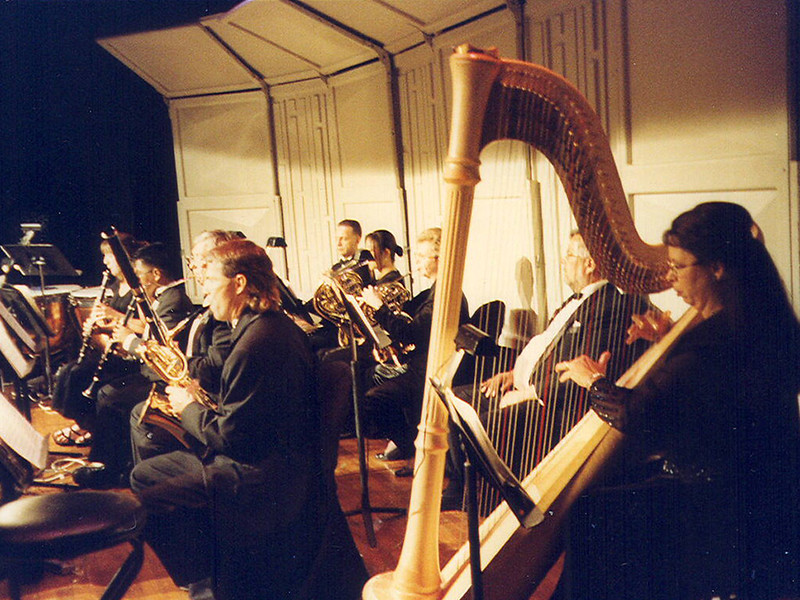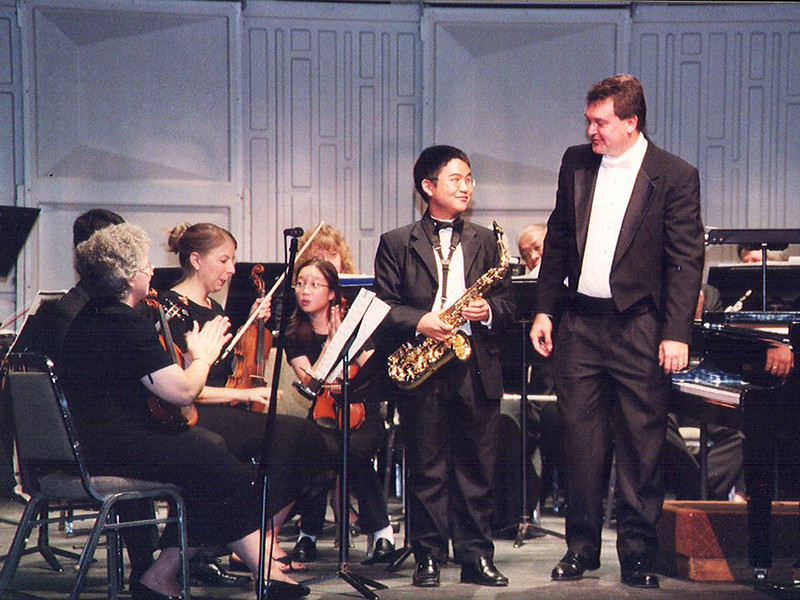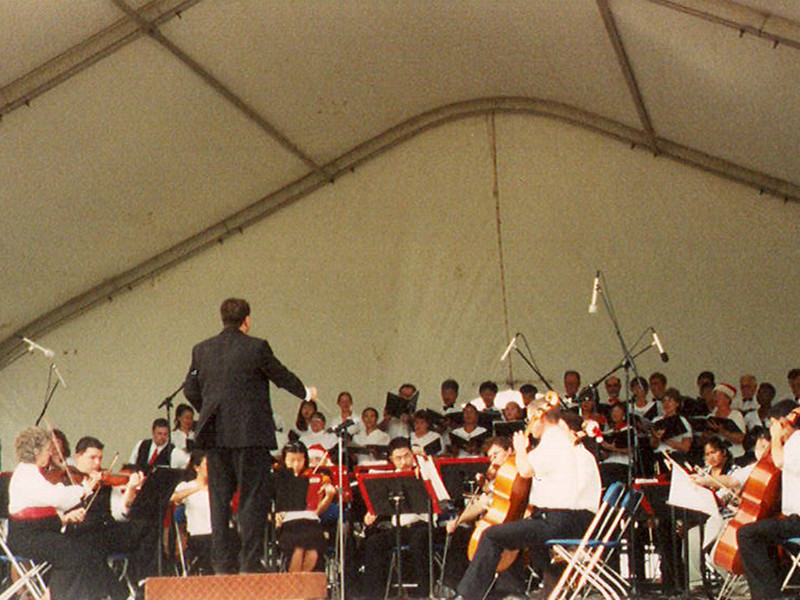1966 saw its formation
Prior to 1966 the Guam Symphonic Wind Ensemble provided Guam with the only live symphonic music performances available. This ensemble was under the direction of David Williams, a music instructor at the then College of Guam. The Guam Symphony Society (GSS) was organized from this group on 5 December 1966 and three months later provided Guam with its premier concert. Both groups were developed under the auspices of providing another rich genre of live music for the people of Guam.
Like the Society, the Guam Symphonic Wind Ensemble was organized to provide the community with a musical environment that would stimulate greater appreciation for concert music. The creation and expansion of the Guam Symphony Society has brought live classical concerts to the 3,000-mile radius of Micronesia. This development has not squelched or decreased the importance of the rich native music but assisted with the growth of a greater appreciation of different genres of music.
The premier season 1967 booklet notes that there were fifty people at the second meeting for the organization of the Society when the first officers were elected. It also states that more people quickly came forward in support of this new cultural endeavor, and that the organizers were surprised at this outpouring of support. Because of this support, the Society swiftly put a plan in motion to bring back the live musical concerts that took place during Guam’s U.S. Naval Era.
Broadened musical appreciation
Navy and local bands played concerts for the enjoyment of the community at the Plaza de España in Hagåtña from about 1903 until 1941. It was because of this that the Society decided to have their first public presentation at this same location. The event was a success despite inclement weather that caused the tiled roof of the bandstand to leak on the musicians and kept most of the audience in their vehicles or huddled under umbrellas and sporting raingear. Regardless of this “stormy” beginning, the Society went on to fill a need in the musical community on Guam.
The original members of the Society who signed the articles of incorporation were Catherine Aguon of Sinajana, Madeline Bordallo of Yona, Pauline Calvo of Barrigada, Pricilla Cruz of Anigua, Carmen Dela Cruz of Hagåtña, Alex Flores of Tamuning, Paul Hendrickson of Mangilao, Waleta Moore of Mangilao, George Toal of Harmon, and Dave Williams of Mangilao.
The mission statement outlines that the Society was established to broaden the musical appreciation of the people of Guam and to enrich the educational experiences of the school-aged children of the island. The Society was successful in organizing several concerts and supporting many others. During the years of 1967 – 1975 the Society did not have a separate viable orchestra but supported The Guam Symphonic Wind Ensemble.
In May 1970 the Guam Symphony Society sponsored the only performance of the Guam Opera Workshop. The outcome of this “Experimental Opera Workshop” was the first and only original Chamorro opera composed and conducted by Dr. David Brian Williams and titled ”Likeweake”. This opera, based on the play “The White Lady on the Bridge at Maina,” was presented in six scenes and was performed four times at the Fine Arts Theatre of the University of Guam.
The first paid conductor to lead the Guam Symphony Orchestra was Earl Sommerville in the 1975-1976 concert season. This season was also supported by a grant from the Guam Insular Arts Council. This was the first of many supporting grants received by this funding organization now known as the Guam Council on the Arts and Humanities Agency.
Over the next ten years (1975 – 1985) the Society developed a chorale and began performing in regular concert seasons, including a yearly concert for the children of Guam’s public schools. During the first years, the Guam Symphony Society sponsored a wide variety of musical activities including a wind ensemble, an original opera, guest conductors and soloists, recitals of all types, a newsletter, a boys choir, a symphony band, Christmas concerts by both the orchestra and chorale, youth concerts, symphony balls, international artists and groups, musical celebrations, and student training programs. Programming consisted of a full spectrum of classical, semi-classical and contemporary composers and works.
The Society’s orchestra and chorale provided Guam with an abundance of performances from small chamber concerts at Agana Shopping Center to full-scale musicals like “Oklahoma!” at the U.S. Naval Station Orote Point Theater. While hosting a number of visiting musicians and musical groups, they coordinated with existing organizations to ensure success and to reach as much of the community as possible.
In April 1980 the Society co-sponsored Paul and Linda Rosenthal, world-renowned violinists from Alaska, to perform a gala concert and share their skills and talent with the local children by visiting and performing in the schools. The Rosenthals’ conducted music lecture-demonstrations at M. U. Lujan, C.L. Taitano, Inalåhan Elementary, Inalåhan Junior High, F.Q. Sanchez, J.P. Torres, Finegayan, Yigo, Andersen, and Tamuning elementary schools.
This event, also sponsored by the Guam Council on the Arts and Humanities Agency (Guam CAHA), is an example of the constant collaboration and educational outreach that continues with the Guam Symphony Society today.
The Guam Symphony Orchestra and Chorale experienced a great time of growth in the mid 1980s with the appointment of Milton Crotts as the Musical Director and Conductor. Jon Anderson, who was on the Guam Symphony Society board for more than fourteen years and having served two terms as president, credited Crotts with much of the growth during this time. Crotts had an ability to seek out musicians, encourage them to participate and bring out their best.
Crotts established a system of visiting professional musicians from Japan through a colleague. This collaboration with the neighboring nation proved to be an outstanding tactical endeavor. It enlarged the orchestra and provided the much needed missing musicians not available on Guam and increased the level at which the local musicians played. Because the Guam Symphony Orchestra is a community orchestra, all of the musicians are volunteers and most have never played professionally. Therefore the opportunity for these “amateur” musicians to play with professionals was also a great boost for the morale and confidence of the local players.
While under the direction of Crotts the Guam Symphony Society was able to hire personnel to ease the expansion and enormous workload that he and the board members were shouldering. In 1990 Kathleen Roos became the first executive director for the Society. Roos’ charges included developing grant proposals for both the federal and private sectors. She was also responsible for arranging facilities for rehearsals and performances, assuring that necessary equipment was on hand, contracting for tickets to be printed, and meeting any other needs that fell into the non-musical category.
Under Crott’s guidance the Society produced several musical operettas and musical plays including “The Pirates of Penzance” (1991), “The Merry Wives of Windsor” (1992), and “Hansel and Gretel” (1993).
Chamorro operettas and musicals
In 1994 while collaborating with the Archdiocese of Agana, the Guam Chamorro Language Commission and the Guam Humanities Council, Crotts organized the translation of Handel’s “Messiah” into Chamorro, and it was performed to packed houses at the Hilton Guam Resort and Spa and at the Dulce Nombre de Maria Cathedral-Basilica in Hagåtña. The Guam Symphony Chorale, the Orchestra, and several soloists participated in this landmark presentation. Guam broke new ground by becoming a progressive international community through the successful translation of a major opera into a native language.
For the first time ever, Guam received media exposure as a place where fine symphonic music is preformed and enjoyed and as a place where local language is promoted and preserved. An excerpt from ”Messiah gi Fino Chamorro” was aired nationwide on National Public Radio. This program is renowned for showcasing outstanding performances across the United States.
In August of 1999 the Guam Symphony Society experienced an unpleasant struggle for leadership and control with the filing of a lawsuit by a former board member. This lawsuit, along with the declining economy, hurt the Society tremendously. Many of the board members of that time describe the events as an unfortunate struggle for power that ultimately resulted in the loss of providing live classical music to the citizens of Guam.
A national search for a new music director was conducted in 2000 to begin the recovery process. Dr. Stephen C. Bednarzyk was selected to fill the position. Bednarzyk was completing the doctoral program in Orchestral Conducting at The University of South Carolina School of Music. He and his wife, Michelle, moved to Guam in August of 2000 and he assumed the position of the Music Director and Conductor of the Guam Symphony Society. Under his direction, the Society has successfully completed three full seasons of live orchestral music.
Even though the crippled economy and dwindling financial support available for the arts caused the Guam Symphony Society to rely strictly on volunteer support staff, between 2000 – 2003 Bednarzyk and the board were able to feature three internationally known professional soloists, continue the Annual Seaside Concerts, the Musikan Famagu’on (A Concert for Young People), Young Artist’s Competition, Harmony Fair and nine other concerts collaborating with more than fifteen local musical and educational entities.
During Bednarzyk’s tenure, Guam Symphony Society has continued local collaboration with other performing arts’ organizations with an impressive performance of Rogers and Hammerstein’s “South Pacific” with Guam’s Gifted and Talented Program (GATE), and Disney’s “Beauty and the Beast” with St. John’s School. The development of a chamber music series was also established in 2005, to bring intimate concert experiences for the people of Guam. The chamber music ensemble performed works such as Mozart’s “Clarinet Quintet”, Dvorak’s “Piano Quintet”, Schumann’s “Dichterlieber”, and Brahm’s “Liebeslieder Waltzes.”
Between the years 2003-2008, Bednarzyk was able to successfully assemble an orchestra comprised of all local musicians, and with this group perform challenging yet audience friendly programs. He developed a consistent programming pattern, including an end of the season gala featuring a different visiting musician each year. Pianist Elizabeth Dela Cruz, cellist Miko Unno, guitarist David Duenas, pianist Jean-Francois Proulx, cellist Diego Garcia, and Internationally renowned violinist Kin-Fung Leung were among those who graced the musical stage with the Guam Symphony Society.
Keeping up with the digital age, the Guam Symphony Society has established an internet presence with a website dedicated to informing the Guam community of their history, their supporters, and their current concert season. Due to the growing community support, under the dedicated board of directors and Bednarzyk’s direction, the Guam Symphony Society was able to hire a part time executive director, Helen Middlebrook, in September 2008.
The Guam Symphony Society maintains its original mission envisioned by the founding members of providing live orchestral music through collaborating with local organizations and sharing their fervor for music with citizens of all ages on the island of Guam.
By Michelle Bednarzyk
For further reading
Miller, Roland S. Guam Symphony Society News. November 1995.
Flores, Alex C. The Guam Symphonic Wind Ensemble Premier Season 1967 Concert Booklet. Tamuning: Metropolitan Press, 1967.


















